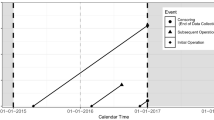Abstract
In medical research, commonly, one is interested in the time to the occurence of a particular event, such as the revision of an implant, and the analysis of these data is referred to as survival analysis. However, for some patients, the event is not observed and their observations are censored. These censored observations are particular to survival data and require specific methods for estimation. The Kaplan and Meier method is a popular method to estimate the probability of being free of the event over time and it is now widely applied in orthopaedics such as to report implant survival. However, one of the assumptions underlying the Kaplan-Meier estimator implies that patients whose observations are censored have the same risk of occurrence of the event than patients remaining in the study. However, because the revision of an implant cannot occur after a patient dies, and that dead patients have their observations censored in the Kaplan-Meier method, another setting must be considered. In the sequel we will demonstrate the inadequacy of the Kaplan-Meier method to estimate implant survival and detail the cumulative incidence estimator.






Similar content being viewed by others
References
Bernoulli D (1760) Essai d’une nouvelle analyse de la mortalité causée par la petite vérole, et des avantages de l’inoculation pour la prévenir. Mémoires de l’académie Royale des Sciences Paris, pp 1–45
Biau D, Faure F, Katsahian S, Jeanrot C, Tomeno B, Anract P (2006) Survival of total knee replacement with a megaprosthesis after bone tumor resection. J Bone Joint Surg Am 88:1285–1293
Biau DJ, Latouche A, Porcher R (2007) Competing events influence estimated survival probability: when is Kaplan-Meier analysis appropriate? Clin Orthop Relat Res 462:229–233
Biau DJ, Davis A, Vastel L, Tomeno B, Anract P (2008) Function, disability, and health-related quality of life after allograft-prosthesis composite reconstructions of the proximal femur. J Surg Oncol 97:210–215
Biau DJ, Larousserie F, Thévenin F, Piperno-Neumann S, Anract P (2009) Results of 32 allograft-prosthesis composite reconstructions of the proximal femur. Clin Orthop Relat Res 468:834–845
Biau DJ, Thévenin F, Dumaine V, Babinet A, Tomeno B, Anract P (2009) Ipsilateral femoral autograft reconstruction after resection of a pelvic tumor. J Bone Joint Surg Am 91:142–151
Cox RD (1972) Regression models and life tables (with discussion). J Roy Stat Soc B 74:187–220
Dobbs HS (1980) Survivorship of total hip replacements. J Bone Joint Surg Br 62:168–173
Falez F, Favetti F, Casella F, Panegrossi G (2008) Hip resurfacing: why does it fail? Early results and critical analysis of our first 60 cases. Int Orthop 32:209–216
Fennema P, Lubsen J (2010) Survival analysis in total joint replacement. An alternative method of accounting for the presence of competing risk. J Bone Joint Surg Br 92:701–706
Fine JP, Gray RJ (1999) A proportional hazard model for the subdistribution of a competing risk. J Am Stat Assoc 94:496–509
Fuchs B, Hoekzema N, Larson DR, Inwards CY, Sim FH (2009) Osteosarcoma of the pelvis outcome analysis of surgical treatment. Clin Orthop Relat Res 467:510–518
Hamadouche M, Boutin P, Daussange J, Bolander ME, Sedel L (2002) Alumina on alumina total hip arthroplasty. A minimal 18.5 -year follow-up study. J Bone Joint Surg Am 84:69–77
Kaplan EL, Meier P (1958) Non parametric estimation from incomplete observations. J Am Stat Assoc 53:448–457
Prentice RL, Kalbfleisch JD, Peterson AVJ, Flournoy N, Farewell VT, Breslow NE (1978) The analysis of failure times in the presence of competing risks. Biometrics 34:541–554
Putter H, Fiocco M, Geskus RB (2007) Tutorial in biostatistics: Competing risks and multi-state models. Stat Med 26:2389–2430
Wangen H, Lereim P, Holm I, Gunderson R, Reikeras O (2008) Hip arthroplasty in patients younger than 30 years: excellent ten to 16-year follow-up results with a HA-coated stem. Int Orthop 32:203–208
Author information
Authors and Affiliations
Corresponding author
Rights and permissions
About this article
Cite this article
Biau, D.J., Hamadouche, M. Estimating implant survival in the presence of competing risks. International Orthopaedics (SICOT) 35, 151–155 (2011). https://doi.org/10.1007/s00264-010-1097-2
Received:
Revised:
Accepted:
Published:
Issue Date:
DOI: https://doi.org/10.1007/s00264-010-1097-2




